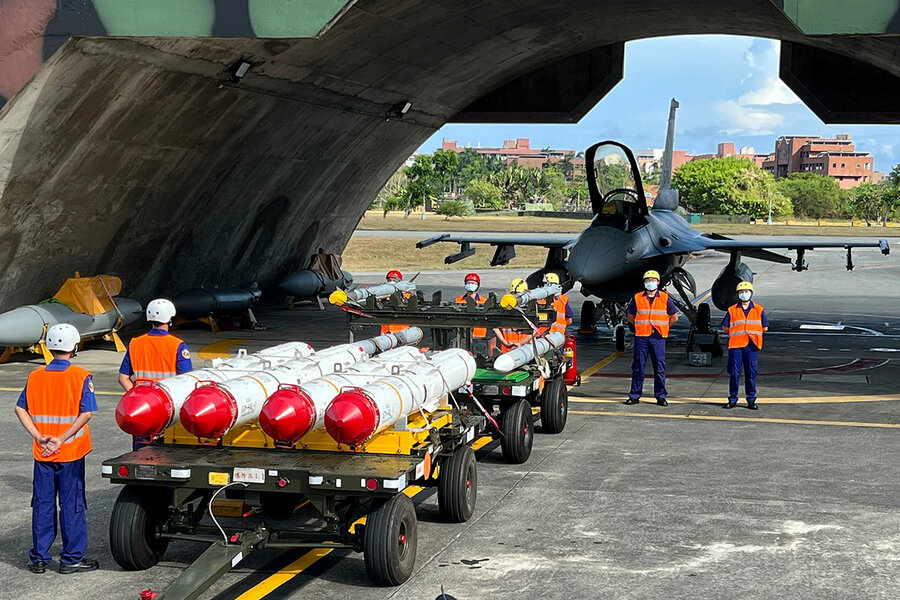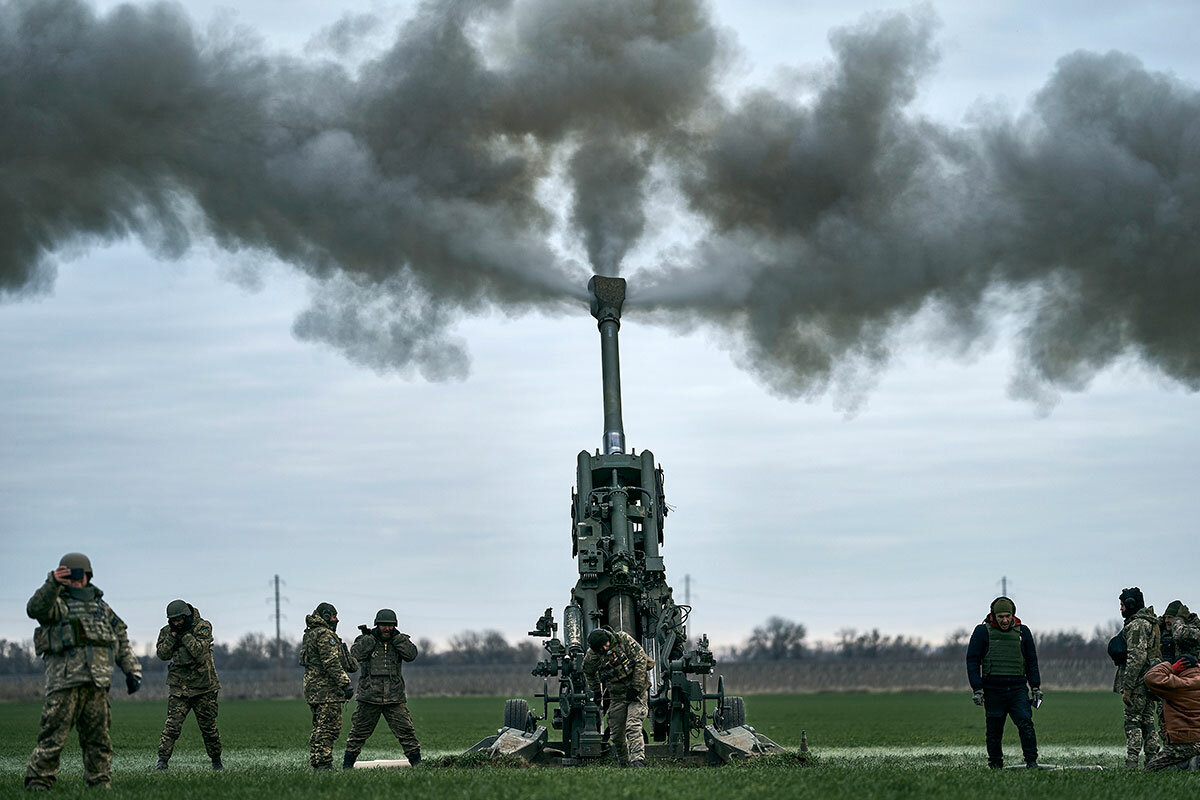With massive weapons aid to Ukraine, can US rebuild its stocks?
Loading...
| Washington
The U.S. has sent more than $45 billion in military aid to Ukraine, significantly drawing down its own stockpiles of key munitions and weapons systems. Among the items provided: more than 10,000 Javelin missiles, tens of thousands of 122 mm rockets, and more than 1.5 million 155 mm artillery rounds.
Replenishing that materiel won’t be easy. The U.S. defense industrial base has evolved into a system based on producing just enough materiel to fulfill regular Pentagon orders. Expanding capacity could require big boosts in machinery, labor, and other manufacturing inputs.
“A lesson learned, I think, for our country from the Ukraine conflict is that our industrial base is not as robust as we need it to be,” said Secretary of the Army Christine Wormuth at a Tuesday event with reporters. “It’s been a wake-up call.”
Why We Wrote This
A story focused onThe U.S. has sent a staggering amount of military aid to Ukraine. This has significantly diminished American stockpiles. Replenishing them is not merely a matter of turning a crank.
Pentagon rhetoric on defense production seems to have taken on a new sense of urgency. Ukraine is a driving factor, but not the only one. The Department of Defense is also preparing against the possibility of a Chinese attack on Taiwan, which itself is sitting on a $19 billion backlog in orders for U.S. arms.
“We have seen in Ukraine and more generally that a constraint and limiting factor for producing key platforms and systems is the industrial base in the United States,” said Dr. Radha Plumb, deputy undersecretary of defense for acquisition and sustainment, at a separate Tuesday Pentagon event. “So what we’re working on is to accelerate production.”
One bottom line: Some of the assumptions that underlie defense industrial base planning need to change. U.S. defense planning had adjusted to the belief that war between major powers is unlikely, and that the duration of other conflicts might be short.
Now the Pentagon is facing an unpredictable long-term commitment to Ukraine and even the possibility, however remote, of direct conflict with China. The U.S. has no self-defense treaty with Taiwan, but President Joe Biden has echoed previous occupants of the Oval Office by saying multiple times that America would defend the island.
“Planning is usually built around short-duration conflicts. We don’t necessarily plan for longer duration like we’re seeing in Ukraine right now,” says Eric Fanning, a former secretary of the Army who is now president of the Aerospace Industries Association.
Just-in-time production now a problem
The American defense industrial base is a vast herd of 60,000 companies and 1.1 million employees. In some ways, its current predicament may be a function of its past success. One of its missions is to innovate, and over the years innovation has streamlined the industry into a precision producer of Pentagon needs.
In recent decades, advances in manufacturing equipment have allowed companies to shed waste and develop a system of just-in-time delivery – meaning they could produce just enough to fulfill orders.
This manufacturing model is more efficient, but it’s also trimmed some of the slack, or surge capacity, from the former system. With only enough employees and equipment to meet the current supply needs, defense companies struggle to accelerate production when demand suddenly rises.
Making this more complicated is the particular structure of the defense industry. Unlike in other fields, the U.S. government is virtually its only customer. That means the government’s needs end up molding the industry itself. If the Pentagon orders a consistent number of 155 mm howitzer shells for years, the companies supplying those will adapt to make only about that many each year.
But rarely more – government demand isn’t guaranteed, which means additional capacity involves taking on additional risk. With very few exceptions, the Pentagon orders all its systems and munitions on a yearly basis. It could want more shells one year, but defense companies don’t know when that year might occur.
“The Pentagon expects companies to maintain all of this excess capacity – workers, machines, equipment – and it’s very costly to have that,” says retired Maj. Gen. John Ferrari, who is now affiliated with the American Enterprise Institute, a think tank.
The problem now is that extra personnel, manufacturing space, and equipment are all necessary to increase production, and increased production is in demand.
Besides the materiel provided to Ukraine, Taiwan too is waiting on its $19 billion in weapons orders. For Taiwan, the military goal is deterrence – meaning that to convince China to not invade, Taiwan needs to show that such an attack would be very punishing or unsuccessful.
Bolstering deterrence underlies the U.S. military relationship with Taiwan as well. Public war games, which admittedly miss key classified information, show the U.S. running out of vital weapons early in a potential war with China.
Efforts to ramp up
Pentagon efforts to bolster the defense industry production capacity have been increasing.
Doug Bush, assistant secretary of the Army for acquisition, logistics, and technology, has spent almost a year and a half coordinating industry and Pentagon officials.
Recently, Pentagon officials have, among other policy tweaks, called for more use of multiyear procurement, or longer-term contracts, which give companies a greater incentive to bulk up production. Such contracts require congressional approval for each use, but are estimated to save 5% to 10% on most orders.
And there have been some results. The 2023 National Defense Authorization Act, the government’s yearly military budget, allowed the Pentagon to issue multiyear contracts for a range of systems and munitions, including the vital 155 mm artillery shells. Months ago, the military received about 14,000 of those a month but has since increased that to 20,000. Secretary Wormuth says that number will ramp up – to about 72,000 by the second half of 2025.
The cost of that added capacity is about $1.5 billion. Finding ways to boost other critical systems with a limited budget is a colossal math problem. The recent debt limit deal increases the Pentagon’s budget by 3% next year, less than the current rate of inflation.
“It’s one pie, the budget,” says Mr. Fanning of the Aerospace Industries Association. “To build surge capacity into it is an expense that comes at a price against something else that you might want.”
Increased production also requires sufficient time to accelerate.
There are ways to max out existing capacity – by hiring more employees (difficult in a tight labor market) and adding a third shift to the schedule. But go beyond that and there are tall hurdles to jump, from building new factory space to acquiring advanced manufacturing equipment to complying with government regulations, says Cynthia Cook, director of the Defense-Industrial Initiatives Group at the Center for Strategic and International Studies, a think tank.
“Ramping up production is not necessarily just a question of turning the crank and increasing what factories are producing,” says Dr. Cook. “It’s a heck of a lot more complicated than that.”
Editor's note: A sentence in this story has been updated to clarify Taiwan's status.







